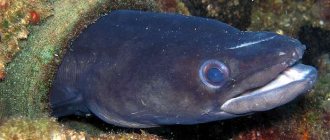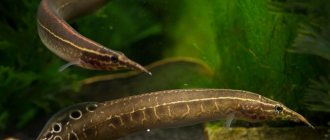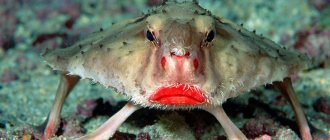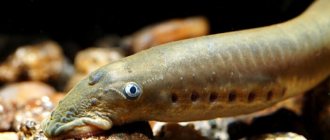People have always been attracted to amazing underwater inhabitants - dangerous, nerve-wracking, with an unusual appearance and no less impressive abilities. The electric eel also falls into this category - how many creatures are there that can generate electrical discharges? This guest from South America, to the delight of aquarists, adapts well to living in home tanks, but how many people decide to get such an extraordinary and controversial pet? And besides, future owners should find out in more detail whether all the stories about these harsh creatures are reality or are they just horror stories?
Electric eel in its natural environment
For the first time, information about these amazing creatures came to Europeans from the Spanish conquerors. The first detailed description dates back to 1729. Almost four decades later, based on the developments of a zoologist from the Netherlands, Jan Gronovius, the Swedish naturalist Carl Linnaeus compiled a detailed description of the individuals and named them scientifically - gymnotus electricu.
These inhabitants should not be confused with eels; despite the same name, they are not even relatives. Electric eels are representatives of the class of ray-finned fish.
Naturalists found it difficult to believe that underwater inhabitants were capable of delivering shocks using electrical discharges. Initially, there was an opinion that the eel does not give an electric shock, but “freezes” its prey. But in the summer of 1772, a member of the Royal Society, John Walsh, proved that the creatures actually stunned their victims with electric shock.
Judging by research, electric eels have existed for more than one millennium, and during this period they have adapted to living in an unfavorable environment; they can survive even in silty, overgrown reservoirs. Most often, these inhabitants are found in turbid fresh waters, without currents, which contain very little oxygen.
They breathe atmospheric air, therefore, in order to take a breath of air, eels must rise to the surface of the water every 10-15 minutes and capture another portion of air. If individuals cannot do this, then they suffocate and drown. But this ability also has a positive side - the eel is able to stay out of the aquatic environment for several hours. He will not die if his body and mouth are kept moist.
References
- "Electrophorus electricus" IUCN Red List of Threatened Species
. Retrieved June 7, 2014. URL of old form - ^ abcd de Santana CD, Crampton WG, Dillman CB, Frederico RG, Sabaj MH, Covain R, et al. (September 2022). "The unexpected species diversity of electric eels with a description of the world's most powerful bioelectricity generator" (PDF). Nature Communications
.
10
(1): 4000. Bibcode: 2019NatCo..10.4000D. doi:10.1038/s41467-019-11690-Z. PMC 6736962. PMID 31506444. Archived from the original (PDF) on September 10, 2022. Retrieved September 10, 2019. - ^ ab Mermelstein, Claudia dos Santos; Costa, Manoel Luis; Moura Neto, Vivaldo (September 2000). "Cytoskeleton of the electric tissue Electrophorus electricus, L." Anais da Academia Brasileira de Ciências
.
72
(3):341–351. DOI: 10.1590/S0001-37652000000300008. ISSN 0001-3765. PMID 11028099. - Jump up
↑ Albert JS (2001).
"Species diversity and phylogenetic systematics of American knifefishes (Gymnotiformes, Teleostei)". Miscellaneous. Publ.
(190): 1–127. HDL: 2027.42 / 56433. - Boutilier R (1990). Gas exchange in vertebrates: from environment to cell. Advances in comparative and environmental physiology 6. Springer-Verlag Berlin. p. 285. ISBN 9783642753800.
- Johansen K, Lenfant C, Schmidt-Nielsen K, Petersen JA (June 1968). "Gas exchange and respiratory control of the electric eel, Electrophorus electricus". Zeitschrift für vergleichende Physiologie
.
61
(2): 137–63. DOI: 10.1007/BF00341112. S2CID 22364103. - ^ abcd Xu J, Lavan DA (November 2008). "Development of artificial cells to exploit biological ion concentration gradients". The Nature of Nanotechnology
.
3
(11): 666–70. Bibcode: 2008NatNa…3..666X. DOI: 10.1038/nnano.2008.274. PMC 2767210. PMID 18989332. - Gill W (2014-12-04). "Electric eels 'control prey remotely'". BBC News
. - "Electric eels remotely control prey's nervous system". 2015-02-17.
- ^ ab Catania KC (April 2022). "Shock and Awe". American scientist
.
320
(4):62–69. - ^ abcde Froese, Rainer and Pauly, Daniel, eds. (2005). "Electric electrophor" in FishBase. Version from December 2005
- Traeger LL, Sabat G, Barrett-Wilt GA, Wells GB, Sussman MR (July 2022). "A tail of two voltages: a proteomic comparison of three electrical organs of the electric eel". Science is advancing
.
3
(7): e1700523. Bibcode: 2017SciA…. 3E0523T. DOI: 10.1126/sciadv.1700523. PMC 5498108. PMID 28695212. - Ching, B., Wu, J. M., Heong, K. K., Bu, M. W., Chu, C., Wong, W. P., et al. (2015-03-20). "Na+/K+-ATPase (nkaα) α-subunit isoforms and their mRNA expression levels, total Nkaα protein content, and Nka kinetic properties in skeletal muscle and three electrical organs of the electric eel, Electrophorus electricus". PLOS ONE
.
10
(3): e0118352. Bibcode: 2015PLoSO..1018352C. DOI: 10.1371/journal.pone.0118352. PMC 4368207. PMID 25793901. - ^ ab Nelson J.S., Grande T.S., Wilson M.V. (2016). Fishes of the World
(5th ed.). John Wiley & Sons, Inc. ISBN. 978-1118342336. - ↑
Catania KC (November 2015).
"Electric eels concentrate their electrical field to cause involuntary fatigue to struggling prey". Current Biology
.
25
(22):2889–98. DOI: 10.1016/j.cub.2015.09.036. PMID 26521183. - Albert JS, Zakon HH, Stoddard PK, Unguez GA, Holmberg SK, Sussman MR (2008). "The case for sequencing the genome of the electric eel, Electrophorus electricus". J. Fish Biol
.
72
(2):331–354. DOI: 10.1111/j.1095-8649.2007.01631.x. - Simon S, Massoulié J (December 1997). "Cloning and expression of acetylcholinesterase from Electrophorus. Splicing of 3' exons in vivo and in transfected mammalian cells". Journal of Biological Chemistry
.
272
(52):33045–55. DOI: 10.1074/jbc.272.52.33045. PMID 9407087. - Zimmerman N, Denston CR (July 1976). "Adenosine triphosphate in cholinergic vesicles isolated from the electric organ of Electrophorus electricus". Brain Research
.
111
(2):365–76. DOI: 10.1016/0006-8993 (76) 90780-0. PMID 949609. S2CID 5619963. - Jump up
↑ Faraday M (1839).
"Experimental Research in Electricity, Fifteenth Series". Philosophical Transactions of the Royal Society
.
129
: 1–12. DOI: 10.1098/rstl.1839.0002. - Roth, Annie (2021-01-14). "Hunting Electric Eels in Swarms, Shocking Catch and Scientists". New York Times
. ISSN 0362-4331. Retrieved January 16, 2022. - Bastos et al (2021).
- Jump up
↑ Assunção MI, Schwassmann HO (1995).
"Reproduction and larval development of Electrophorus electricus
on the island of Marajo (Para, Brazil)".
Ichthyological studies of fresh waters
.
6
(2): 175–184. ISSN 0936-9902. - ^ ab Piper, Ross (2007), Uncommon Animals: An Encyclopedia of Curious and Unusual Animals
, Greenwood Press. - van der Sleen P, Albert JS, eds. (2017). A Field Guide to the Fishes of the Amazon, Orinoco and Guiana. Princeton University Press. item 331. ISBN. 9781400888801. OCLC 1004848434.
- "Electric eel". Tennessee Aquarium. Retrieved February 1, 2015.
- Jump up
↑ Phillips C (January 16, 2015).
"Snap, Crackle, Tweet: Tennessee Tech Helps Aquarium Electric Eel Make a Social Media Stir". Chattanooga Times Free Press
. Retrieved February 1, 2015. - Jump up ↑
Jordan DS (1963). Genera of fish and classification of fish. Stanford University Press. paragraph 330. - van der Sleen P, Albert JS, eds. (2017). A Field Guide to the Fishes of the Amazon, Orinoco and Guiana
. Princeton University Press. pp. 330–334. ISBN 978-0691170749. - Ferrari Jr CJ de Santana CD, Vari RP (2017). "Checklist of Gymnotiformes (Osteichthyes: Ostariophysi) and catalog of major phyla". Neotropical. Ichthyol
.
15
(1). DOI: 10.1590/1982-0224-20160067.
Appearance and structural features
If you evaluate the appearance of these creatures, then they can hardly be called cute or pleasant; they look like fossil creatures from ancient times:
- the eel has an elongated body , slightly compressed from the sides and behind, slightly rounded in front;
- The color of adult individuals is presented in green-brownish tones;
- the color of the throat and lower part of the slightly flattened head is bright red;
- Compared to other fish, eels have no scales, their skin consists of mucus;
- the average length is about one and a half meters with a weight of up to 20 kg, but in nature there are also 3-meter giants;
- individuals lack dorsal and ventral fins, which further gives them a snake-like appearance;
- Electric eels move in waves, using a large sub-caudal fin . They can move equally easily to the bottom and to the surface, forward and backward;
- pectoral fins – small, used as stabilizers during movement of an individual.
Electric eels are solitary in life; most often they are at the bottom of a reservoir, hovering motionless among dense vegetation. They are nocturnal predators, showing maximum activity in the dark. The main diet consists of small fish, amphibians, crustaceans, and if the eel is lucky, then feathered or small animals appear on its “menu”. Like snakes, these creatures swallow their prey whole.
Feeding
A predator, he eats everything he can swallow. In nature, these are usually fish, amphibians, and small mammals.
Juveniles eat insects, but adult fish prefer fish. At first they need to be fed with live fish, but they are also capable of eating protein foods such as fish fillets, shrimp, mussel meat, etc.
They quickly understand when they will be fed and rise to the surface to beg for food. Never touch them with your hands, this may result in a severe electric shock!
Unique Features
According to scientists, there is nothing unusual in the ability of these fish to create electrical energy. Almost all living organisms do this to one degree or another. For example, the control of muscle fibers by the human brain is also carried out thanks to electrical signals.
The eel body produces electricity in the same way as nerve and muscle fibers in the human body. Electrocyte cells accumulate energy charges extracted from food. Due to their synchronous generation of action potentials, a short electrical discharge is formed. Because the thousands of small charges generated by each cell add up, a voltage of up to 650 volts is created.
Eels are capable of emitting electrical discharges of varying strengths, and each of them has its own purpose: the impulse can become defensive, occurring during hunting, resting or searching actions of an individual. When an eel sinks to the bottom and rests calmly, its body does not emit any signals.
Hunting impulses
A hungry individual begins to move slowly in the water, while generating weak impulses of up to 50 volts, the duration of which does not exceed 2 ms. When the fish notices a possible prey, their frequency and amplitude increases to 300-600 volts, they last from 0.6 to 2 ms.
Thanks to such “messages” the hunter manages to paralyze the prey. To suppress the fish, which make up the lion's share of the diet of these predators, they use high-frequency pulses. Taking breaks between shocks allows the eel to regain its energy.
When the prey is immobilized, it sinks to the bottom, and the fish, slowly, approaches it and swallows it completely. Then she needs rest - a period during which the food must be digested.
Protective impulses
Enemies who want to “offend” the electric eel will be in trouble - these individuals use rare high-frequency impulses - 2-7 pieces, and 3 search impulses with a small amplitude.
Hunting for prey
The electric eel attacks without warning and does not give in even to large prey. If any living creature appears next to the eel, it immediately shudders with its whole body, forming a discharge of 300-350 V, which instantly kills all potential prey nearby, mainly small fish. Having waited for the paralyzed fish to sink to the bottom, the eel calmly swims up to it and swallows it whole, after which it rests for several minutes, digesting the food.
It is almost impossible to catch an electric eel with a fishing rod; this trick does not work well on it, since it does not have good eyesight. I came across this copy by accident. After photographing, he was released home, back into the water. Photo credit: Seig.
Electrolocation
Thanks to the use of electric organs, representatives of this species not only hunt and defend themselves. They also use low power discharges of up to 10 volts for electrolocation. By nature, these fish have poor vision, and as individuals age, it becomes much worse. Information about their surroundings comes to them in a different way - through electrical sensors located on their body.
In photographs taken in the underwater environment, these receptors are noticeable in individuals - an electric field begins to pulsate around the moving fish. As soon as an object appears near the creature, the shape of the field changes significantly. Using special receptors with which individuals detect the electric field distortions they themselves create, they detect a road and a hiding victim in a turbid aquatic environment.
This incredible sensitivity can be called an excellent advantage, allowing fish to be more successful in hunting and defense than creatures that rely on more familiar visual, tactile and other organs.
external links
- A 1954 educational film about the electric eel from the Moody Institute of Science.
| Taxon identifiers |
|
Protecting acne from electric shocks
The electricity that eels generate when they hunt can reach a power of six hundred volts. This is a deadly weapon against small inhabitants - frogs, fish, crustaceans. Larger representatives of the aquatic world, such as caimans, anacondas and tapirs, do not rush to dangerous areas.
Why can these dangerous creatures strike other inhabitants, but do not suffer from deadly discharges themselves? It's all about the location of the fish's vital organs; their brain and heart muscle are located next to the head and are protected by fatty tissues that insulate them. The skin of individuals also has a similar effect. Experts note that fish with damaged skin are most vulnerable to electrical shocks.
In addition, another feature was identified - when mating, individuals generate high-power discharges, but they do not harm the partner. Moreover, if this happens outside the mating season, the individual who received such a discharge may die. This supports the fact that eels can activate and disable the system that protects them from electrical current.
further reading
| Wikispecies has information related to Electrophorus electricus . |
| Wikimedia Commons has media related to Electrophorus electricus . |
| Look up electric eel in Wiktionary, the free dictionary. |
- Bastos, D.A., Zuanon, J., Pi-Daniel, L.S., and de Santana, C.D., (January 2022), “Social predation by electric eels,” Ecology and Evolution. DOI: 10.1002/ece3.7121
- Catania, K. (December 2014). "The shocking predatory strike of an electric eel." The science
.
New York NY 346
(6214):1231–4. Bibcode: 2014Sci...346.1231C. DOI: 10.1126/science.1260807. PMID 25477462. S2CID 14371418. - Catania, KC (June 2016). "Jumping eels electrify threats, confirming Humboldt's account of the battle with horses". Proceedings of the National Academy of Sciences of the United States of America
.
113
(25):6979–84. DOI: 10.1073/pnas.1604009113. PMC 4922196. PMID 27274074. - Catania KC (September 2022). "Energy transfer to humans during electric eel shock jump". Current Biology
.
27
(18): 2887–2891.e2. DOI: 10.1016/j.cub.2017.08.034. PMID 28918950. - Finger S (2010). "Dr. Alexander Garden, the Linnaean in Colonial America, and the Saga of the Five 'Electric Eels'." Perspectives in Biology and Medicine
.
53
(3):388–406. DOI: 10.1353/pbm.0.0163. PMID 20639607. S2CID 8544900. - Finger S, Piccolino M (2011). The Shocking History of Electric Fish: From Ancient Eras to the Birth of Modern Neurophysiology
. New York: Oxford University Press. - Gervais, R. (2017). "Phenomenological understanding and electric eels". Theory
.
32
(3):293–302. DOI: 10.1387/theoria.17294. - Plumb C (September 2010). "The Electric Shock" and the "Electric Spark": Anatomists and Eroticism in George Baker's Electric Eel Exhibition of 1776 and 1777." Endeavor
.
34
(3): 87–94. DOI: 10.1016/j.endeavour.2010.06.003. PMID 20674027. - Traeger LL, Sabat G, Barrett-Wilt GA, Wells GB, Sussman MR (July 2022). "A tail of two voltages: a proteomic comparison of three electrical organs of the electric eel". Science is advancing
.
3
(7): e1700523. Bibcode: 2017SciA…. 3E0523T. DOI: 10.1126/sciadv.1700523. PMC 5498108. PMID 28695212. - Turkel W. J. (2013). A Spark from the Deep: How Shocking Experiments with a Highly Electric Fish Led to Scientific Discoveries
. Baltimore: Johns Hopkins University Press.
How do electric eels reproduce?
These inhabitants spawn, preferring to do this in the dry season. Couples also reunite thanks to the impulses they actively send during the mating season. The construction of a secluded nest is carried out by the male; he constructs it from saliva. And the female lays up to 1,700 eggs in it. Electric eels are caring parents and take care of their offspring together.
The hatched fry are light ocher in color; some individuals have marbled streaks. Those individuals that hatched earlier than the others eat the remaining eggs. The main diet of newly hatched offspring is small invertebrates.
The development of electrical organs in babies begins after the size of individuals reaches 40 mm. Small larvae can also generate current, but only with a very modest power - 3-4 tens of millivolts. If you place a 2-4 day old fry on your palm, you will feel a slight tingling sensation. Individuals become independent when they reach 10-12 cm in length.
Taxonomic history
The species is so unusual that it has been reclassified several times. When originally described by Carl Linnaeus in 1766, it used the name Gymnotus electricus
, placing it in the same genus as
Gymnotus carapo
(ribbon knifefish) which he described several years ago.
It was only about a century later, in 1864, that the electric eel was transferred to its own genus Electrophorus
by Theodore Gill. [27]
The electric eel was later considered special enough to have its own family, Electrophoridae, but it has since been grouped back into the family Gymnotidae along with Gymnotus
. [14] [28] [29]
In September 2022, C. David de Santana et al published work strongly suggesting the division of Electrophorus electricus
into three species based on DNA divergence, ecology and habitat, anatomy and physiology, and electrical abilities.
Three species are offered: E. electricus
,
E. voltai
sp.
Nov, and E. varii
sp. Nov [2]
Keeping an electric eel in a home tank
These fish adapt well to aquarium conditions, here males can live 10-15 years, females - 20-22 years. But the life expectancy of their wild counterparts is not known for certain. To make the resident feel comfortable, the owner should take care of the following:
- a spacious aquarium, at least 3 meters long, one and a half to two meters deep;
- water of certain parameters: with a temperature of about 25°C, hardness from 11 to 13 mol/m³ and acidity - 7-8 pH.
Experts do not advise frequently replacing water, as this can cause the formation of ulcers on the skin of fish and their subsequent death. The mucous coating of acne includes antibacterial substances that protect the skin from ulcers, and with frequent changes of water, their concentration steadily decreases, and the skin becomes vulnerable.
Eels are quite aggressive towards their fellows, even outside the spawning period, so it is not recommended to have more than one individual in one tank.
Should a person be afraid of this creature?
If we take into account all the information, and it often turns out to be false, the electric eel is an extremely dangerous creature, capable of killing even an adult, physically strong person. But in fact, when receiving a discharge from a small individual, a person may lose consciousness, but the electric shock does not lead to death. The current of this creature causes muscle tissue to contract and leads to numbness. This unpleasant feeling can last for more than one hour.
Larger eels generate a higher voltage current, and the consequences can really be critical. These predators do not give in even to larger animals. And if they find themselves a few meters away from it, the eel prefers not to run away, but to go on the attack. Therefore, you should not approach these creatures closer than three meters.
In some world cuisines, electric fish are considered a real delicacy; catching them is a rather dangerous activity. But local residents have shown ingenuity and are catching eels with the help of cows, since electric discharges have practically no effect on them.
Shepherds lead their flocks into the water and wait for the alarmed, loudly mooing and rushing animals to calm down. Then the cattle are driven out of the reservoir and, with the help of nets, individuals who have already spent their discharges are caught. The electric eel is not able to constantly generate electric current, and over time the discharges weaken and stop altogether.
The electric eel is a dangerous predator; if you compare the number of its victims with the “success” of piranhas, the latter lose 100%. Of course, not every owner will decide to have such an ambiguous pet, but if the desire continues, it’s worth first getting to know its habits and needs.











